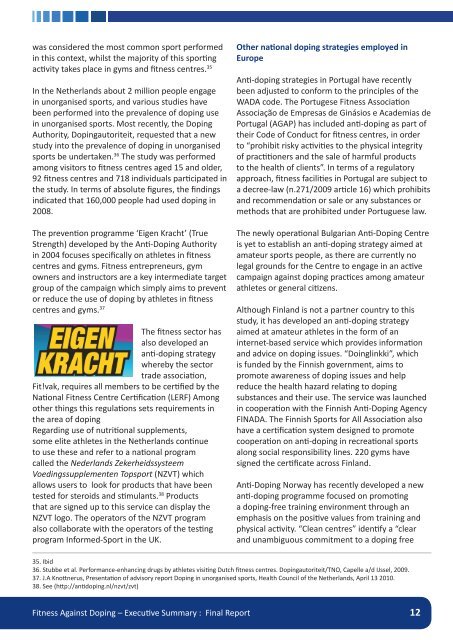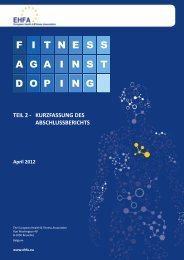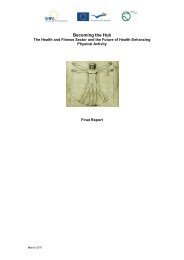FINAL REPORT - the EHFA Projects & Programmes
FINAL REPORT - the EHFA Projects & Programmes
FINAL REPORT - the EHFA Projects & Programmes
Create successful ePaper yourself
Turn your PDF publications into a flip-book with our unique Google optimized e-Paper software.
was considered <strong>the</strong> most common sport performed<br />
in this context, whilst <strong>the</strong> majority of this sporting<br />
activity takes place in gyms and fitness centres. 35<br />
In <strong>the</strong> Ne<strong>the</strong>rlands about 2 million people engage<br />
in unorganised sports, and various studies have<br />
been performed into <strong>the</strong> prevalence of doping use<br />
in unorganised sports. Most recently, <strong>the</strong> Doping<br />
Authority, Dopingautoriteit, requested that a new<br />
study into <strong>the</strong> prevalence of doping in unorganised<br />
sports be undertaken. 36 The study was performed<br />
among visitors to fitness centres aged 15 and older,<br />
92 fitness centres and 718 individuals participated in<br />
<strong>the</strong> study. In terms of absolute figures, <strong>the</strong> findings<br />
indicated that 160,000 people had used doping in<br />
2008.<br />
The prevention programme ‘Eigen Kracht’ (True<br />
Strength) developed by <strong>the</strong> Anti-Doping Authority<br />
in 2004 focuses specifically on athletes in fitness<br />
centres and gyms. Fitness entrepreneurs, gym<br />
owners and instructors are a key intermediate target<br />
group of <strong>the</strong> campaign which simply aims to prevent<br />
or reduce <strong>the</strong> use of doping by athletes in fitness<br />
centres and gyms. 37<br />
The fitness sector has<br />
also developed an<br />
anti-doping strategy<br />
whereby <strong>the</strong> sector<br />
trade association,<br />
Fit!vak, requires all members to be certified by <strong>the</strong><br />
National Fitness Centre Certification (LERF) Among<br />
o<strong>the</strong>r things this regulations sets requirements in<br />
<strong>the</strong> area of doping<br />
Regarding use of nutritional supplements,<br />
some elite athletes in <strong>the</strong> Ne<strong>the</strong>rlands continue<br />
to use <strong>the</strong>se and refer to a national program<br />
called <strong>the</strong> Nederlands Zekerheidssysteem<br />
Voedingssupplementen Topsport (NZVT) which<br />
allows users to look for products that have been<br />
tested for steroids and stimulants. 38 Products<br />
that are signed up to this service can display <strong>the</strong><br />
NZVT logo. The operators of <strong>the</strong> NZVT program<br />
also collaborate with <strong>the</strong> operators of <strong>the</strong> testing<br />
program Informed-Sport in <strong>the</strong> UK.<br />
O<strong>the</strong>r national doping strategies employed in<br />
Europe<br />
Anti-doping strategies in Portugal have recently<br />
been adjusted to conform to <strong>the</strong> principles of <strong>the</strong><br />
WADA code. The Portugese Fitness Association<br />
Associação de Empresas de Ginásios e Academias de<br />
Portugal (AGAP) has included anti-doping as part of<br />
<strong>the</strong>ir Code of Conduct for fitness centres, in order<br />
to “prohibit risky activities to <strong>the</strong> physical integrity<br />
of practitioners and <strong>the</strong> sale of harmful products<br />
to <strong>the</strong> health of clients”. In terms of a regulatory<br />
approach, fitness facilities in Portugal are subject to<br />
a decree-law (n.271/2009 article 16) which prohibits<br />
and recommendation or sale or any substances or<br />
methods that are prohibited under Portuguese law.<br />
The newly operational Bulgarian Anti-Doping Centre<br />
is yet to establish an anti-doping strategy aimed at<br />
amateur sports people, as <strong>the</strong>re are currently no<br />
legal grounds for <strong>the</strong> Centre to engage in an active<br />
campaign against doping practices among amateur<br />
athletes or general citizens.<br />
Although Finland is not a partner country to this<br />
study, it has developed an anti-doping strategy<br />
aimed at amateur athletes in <strong>the</strong> form of an<br />
internet-based service which provides information<br />
and advice on doping issues. “Doinglinkki”, which<br />
is funded by <strong>the</strong> Finnish government, aims to<br />
promote awareness of doping issues and help<br />
reduce <strong>the</strong> health hazard relating to doping<br />
substances and <strong>the</strong>ir use. The service was launched<br />
in cooperation with <strong>the</strong> Finnish Anti-Doping Agency<br />
FINADA. The Finnish Sports for All Association also<br />
have a certification system designed to promote<br />
cooperation on anti-doping in recreational sports<br />
along social responsibility lines. 220 gyms have<br />
signed <strong>the</strong> certificate across Finland.<br />
Anti-Doping Norway has recently developed a new<br />
anti-doping programme focused on promoting<br />
a doping-free training environment through an<br />
emphasis on <strong>the</strong> positive values from training and<br />
physical activity. “Clean centres” identify a “clear<br />
and unambiguous commitment to a doping free<br />
35. Ibid<br />
36. Stubbe et al. Performance-enhancing drugs by athletes visiting Dutch fitness centres. Dopingautoriteit/TNO, Capelle a/d IJssel, 2009.<br />
37. J.A Knottnerus, Presentation of advisory report Doping in unorganised sports, Health Council of <strong>the</strong> Ne<strong>the</strong>rlands, April 13 2010.<br />
38. See (http://antidoping.nl/nzvt/zvt)<br />
Fitness Against Doping – Executive Summary : Final Report 12




